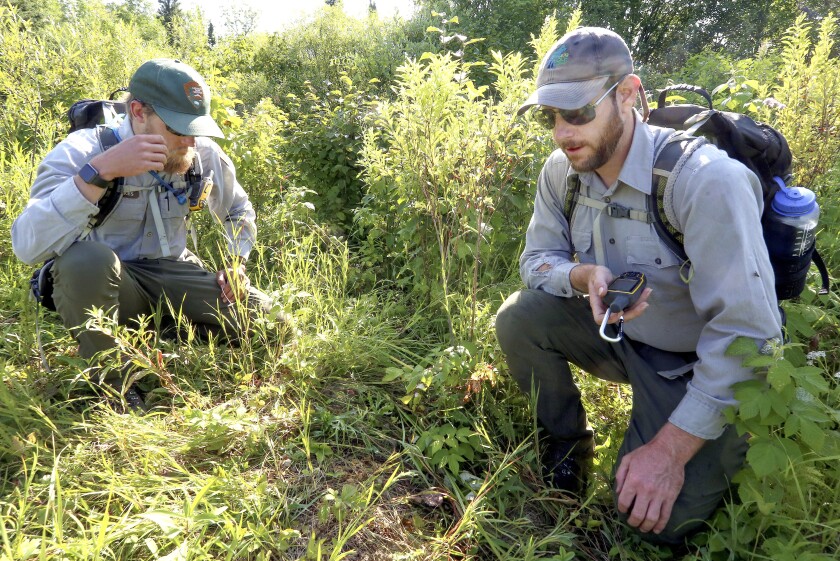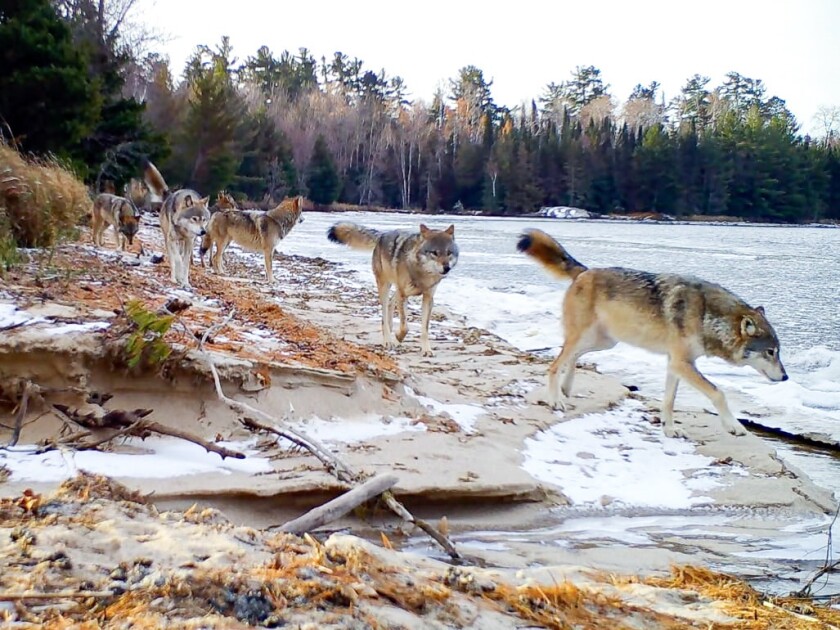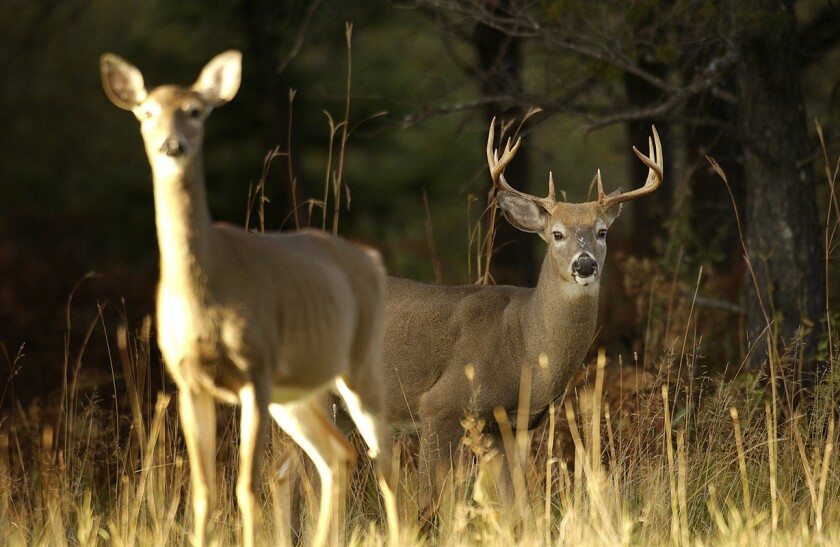DULUTH — A billboard claiming wolves kill and eat 54,000 deer fawns every year in northern Minnesota has rekindled the debate over the big predator’s role in the state and whether hunting and trapping is needed to keep wolf numbers in check.
The sign has also raised some eyebrows over its accuracy.
ADVERTISEMENT
The billboard, which went up in September along busy U.S. Highway 53 in Cotton, about 30 miles north of Duluth, claims that “Wolves devour over 54,000 fawns a year in Minnesota.”
The billboard was paid for by the Sturgeon River Chapter of the Minnesota Deer Hunters Association. The chapter posted on social media that it's intended to promote wolf management, state-sanctioned hunting and trapping seasons to reduce wolf numbers.
The issue is currently moot because a 2022 federal court decision is keeping wolves under the protection of the Endangered Species Act across much of the U.S. outside the Rocky Mountains.
There’s no doubt that wolves (and black bears and bobcats) kill a lot of fawns every year in the state, mostly in June and July before fawns are fast enough to escape. Wolves in fact are the primary cause of non-human mortality for all deer in Northeastern Minnesota, according to the Department of Natural Resources.
But critics say the billboard’s number simply doesn’t add up, and that in fact there is no scientific data on how many deer or deer fawns the state’s estimated 2,700 wolves kill each year.

Researchers with the Voyageurs Wolf Project in and around Voyageurs National Park say they have documented one wolf that killed as many as 38 fawns in a year while some haven’t been good enough hunters to kill any. The average yearling wolf, which makes up the majority in packs, may kill three to five fawns in a year in the Voyageurs area as they learn how to hunt, said Thomas Gable, lead researcher in the project.
But Gable said there is no way to take site-specific research data and extrapolate it across an area as large and diverse as northern Minnesota. Wolves are also eating moose, beaver, snowshoe hares, fish, berries and human food left out as bait or left behind as garbage.
ADVERTISEMENT
“If you want to say you don’t like wolves and that you want to shoot some, that’s fine, that’s your opinion,” Gable said. “But when you try to bring in a number that has no scientific basis, and which just can’t hold up, then that’s a problem. It’s not factual. It might be higher, it might be lower. We just don’t know.”

Social media sensation
Gable posted about the billboard on Facebook last week where the Voyageurs Wolf Project has 232,000 followers and said no one has come forward to offer evidence that the 54,000 number is valid. Across Twitter, Facebook and Instagram, Gable said a series of posts about the billboard reached 728,660 people as of Monday.
“If you want to look at the science of predator/prey relationships, there is ample research out there that shows killing a few wolves, or even if you killed all the wolves, doesn't mean you get more deer. There are other limiting factors … and fawns die from all sorts of reasons other than wolves. Minnesota deer hunters kill 25,000 fawns each year,” Gable noted. “And if you got rid of wolves, nature would fill the void, maybe with coyotes. And coyotes kill a lot of deer fawns where their densities are high.”

Dan Stark, large carnivore specialist for the Minnesota DNR, said he knows of no accurate estimate of fawn predation across the state.
“There’s no information available to determine whether the estimate (54,000) is accurate or evaluate how close it is to the actual number,” Stark told the News Tribune. “The annual percentage of young fawns taken by wolves, and other predators, in Minnesota are still relatively unknown.”
Stark added that the most recent data from field research in Minnesota shows black bears and even bobcats both killed more fawns than wolves.
ADVERTISEMENT
Jared Mazurek, executive director of the statewide Minnesota Deer Hunters Association, the state’s largest deer hunter advocacy group with about 20,000 members, said the billboard was not approved or paid for by the statewide organization.
“The state organization was not involved in this initiative,” Mazurek said. “You are correct that the intention behind the billboard was to advocate for wolf management within the state. However, I agree that this message is not clearly conveyed by the statement on the billboard. We are contacting our chapters around the state to ensure that any type of public messaging such as this, must go through our state office so that we can align our message and ensure that we are sticking to the science and providing an appropriate call to action.”
But Mazurek said the statewide group does indeed support wolf management and wolf reduction efforts. In fact, this year the association is boycotting the Minnesota Governor’s Deer Hunting Opener festivities because of Gov. Tim Walz’s opposition to wolf hunting and trapping.
“Wolf population estimates clearly show that we are above target population numbers. The U.S. Fish and Wildlife Service set a recovery goal of 1,251-1,400 wolves within the state. To provide a buffer, the DNR expanded that goal to 1,600 wolves. The wolf population in Minnesota has stabilized at around 2,700 wolves,” Mazurek noted. “With an increasing human population and resulting habitat fragmentation, this is not an ecologically sustainable population for wolves in the state.”

Deer thrived with wolves when winters were less snowy
The current population estimate of 2,700 is about the same or even down some from 20 years ago when Northeastern Minnesota had record-high deer populations and record-high deer harvest by hunters. Biologists say that fact shows deer numbers can climb even with wolves around — if they have good habitat and mild winters.
But a trend toward deep-snow winters over the past 10 years has conspired to bring deer numbers down in the northeast. Biologists say habitat and winter severity may be bigger issues for deer at the far northern fringe of their range, with wolves then piling on during harsh winters.
ADVERTISEMENT
The Minnesota DNR has a new wolf management plan that generally keeps wolves near their current level, but also allows the option of hunting and trapping seasons if wolf numbers spike or their range expands more. Under current state law, the decision on any wolf season is up to the agency, but only if federal protections are removed.
“Predator control alone isn’t the answer. But it can be a component,’’ Stark said. “Wolves are the primary cause of natural mortality on deer in northern Minnesota, but there has been little evidence that wolves alone are a limiting factor on deer or have caused population declines across the entire range. From 2003 to 2007, we had record-high deer harvests in Minnesota, which coincided with the highest wolf population estimate.”
Those highest-ever deer numbers, even with modern record wolf numbers, were likely the result of a string of mild winters and a period of good deer habitat, Stark said. At that point, it didn’t matter how many deer that wolves killed because there were still plenty of deer for hunters.
Meanwhile, wolf advocates say the billboard shows the ongoing animosity many wolf opponents have toward the big canine, one reason federal protections are still warranted.
“The misinformed hostility that fueled efforts to wipe out the nation’s wolves (in the past) still exists today,” said Collette Adkins, carnivore conservation director at the Center for Biological Diversity. “This billboard shows that wildlife conservationists like me have a lot of work to do to educate people about the ecological importance of wolves and other carnivores.”
It's estimated as many as 2 million gray wolves once roamed North America, including much of the contiguous United States. But European settlers nearly wiped the animals out of the U.S., outside Alaska, with fewer than 500 remaining — all of them in Minnesota's Superior National Forest — by the time the wolf received federal protections in the 1970s.
Groups representing ranchers, hunters and farmers say wolves have since recovered enough in Minnesota, Wisconsin and northern Michigan to remove federal protections and resume state wolf hunting and trapping seasons in those states.
ADVERTISEMENT
But wolf supporters note that the animals are still only at about 1% of their historical numbers and occupying only about 15% of their historical range. A national wolf recovery plan, they say, should look at additional places wolves could roam beyond where they are now.
In November 2020, the Trump administration finalized a rule that removed all Endangered Species Act protections from most gray wolves nationwide. But a federal court vacated that rule in February 2022 and restored the wolf's federal protection in the lower 48 states except for the northern Rocky Mountains. So far, that court action is holding with no sign wolves will be delisted soon.
The U.S. Fish and Wildlife Service under the Biden administration has announced it will try again in 2024 to draft a wolf delisting plan that will hold up in court.












